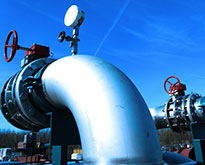In 2021, the EU’s natural gas import dependency rate was 83%. This is 1 percentage point (pp) less than 2020 (84%). This small decrease in import dependency was significantly influenced by the fact that most EU Member States used stocks of natural gas that were imported in previous years. In fact, the drop in natural gas stocks in 2021 was the largest since the start of the time series (2008).
The EU Member State with the highest dependency on natural gas imports in 2021 was Malta (104%), followed by Sweden (102%) and Lithuania (101%), which have increased their stocks. On the other hand, the lowest dependency on natural gas imports was recorded in Romania (24%), followed by Denmark (26%) and the Netherlands (33%).
Source dataset: nrg_cb_gasm
The impact of a potential import disruption needs to take into account the importance of natural gas in the overall energy mix. While the import dependency in Sweden, Finland and Estonia is near 100%, the share of natural gas in the energy mix is relatively low (3%, 7% and 8% respectively). By contrast, the highest share of natural gas in the energy mix is in Italy (40%) and its import dependency is 94%. The Netherlands has the 2nd highest share of natural gas in its energy mix, however its import dependency is much lower, due to its domestic production of natural gas.
When compared with 2020, the largest increases in the dependency rate on natural gas imports were recorded in Malta (from 96% in 2020 to 104% in 2021; +8 pp), Ireland (from 64% to 71%; +7 pp) and Romania (from 17% to 24%; also +7 pp).
At the other end of the scale, the largest decreases were recorded in Latvia (from 121% to 61%; -59 pp), Austria (from 73% to 51%; -22 pp) and Slovakia (from 88% to 69%; -20 pp).
For more information:
- Table depicting EU countries’ share of natural gas in the overall energy mix (2020) and the natural gas import dependency in 2020 and 2021
- Statistics Explained article on natural gas supply
- Dedicated section on energy
- Database on energy
Methodological notes:
- Energy dependency is calculated as net imports/inland demand.
- Share in the overall energy mix is calculated from data on energy balances for the aggregate “Gross available energy”.
To contact us, please visit our User Support page.
For press queries, please contact our Media Support.


